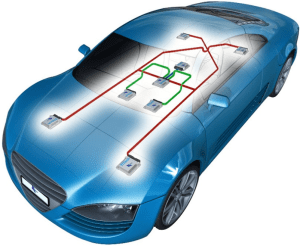
Automobiles
An embedded system is an electronic or computer system which is designed to control, access the data in electronics based systems. This system includes a single chip microcontroller such as cortex, ARM and also microprocessors, FPGAs, DSPs, and ASICs. Nowadays the usage of embedded systems is widespread. But the software that is programmed into the microcontroller is capable of solving only a limited range of problems.
An advanced embedded system in automobiles has increased rapidly in the past two decades. Every year automobile manufacturers pack embedded systems into their cars for different functionalities like ignition, security and audio systems. The technological innovations of the embedded system within the vehicle are being ambitiously challenged to make the vehicle energy efficient, network savvy and safer. In 1968, the Volkswagen used first embedded system in the automobile industry.
Embedded Systems’ Applications
Embedded systems have a huge variety of applications that varies from low to high-cost consumer electronics to industrial equipments, medical devices to weapon control systems, aerospace systems and entertainment devices to academic equipments, and so on. Embedded systems span all features of our present life. The applications of embedded systems are shown below.
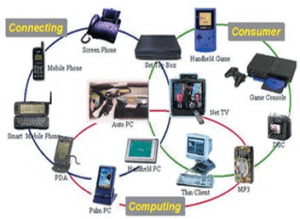
Embedded systems applications
- Home Appliances: Washing machines, microwave appliances, security systems, dishwashers, DVD, HV and AC systems, etc.
- Automobile: Airbag systems, GPS, anti-locking brake system, fuel injection controller devices, etc.
- Office Automation: Copy Machine, Fax, modem, smart phone system, printer, and scanners.
- Entertainment: Video games, mp3, mind storm, smart toy, etc.
- Security: Building security system, face recognition, airport security system, eye recognition system, alarm system, finger recognition systems, etc.
- Industrial Automation: Voltage, temperature, current, and hazard detecting systems, data collection systems, assembly line, monitoring systems on pressure.
- Aerospace: Flight attitude controllers, space robotics, automatic landing systems, navigational systems, space explorer, etc.
- Medical: Medical diagnostic devices: ECG, EMG, MRI, EEG, CT scanner, BP Monitor, Glucose monitor.
- Banking and Finance: Share market, cash register, smart vendor machine, ATM
- Telecommunication: Cellular phone, web camera, hub, router, IP Phone
- Personal: Data organizer, iPhone, PDA, palmtop.
Introduction to Automobiles Industry
As far as automobile industry is concerned, a wide range of industries and companies are involved in the development, designing manufacturing and selling of cars, bikes, buses, etc. India represents one of the world’s largest automobile markets. From the past few years, even the middle-class has started showing interest in buying a vast range of cars or vehicles. The growth of the Indian automobile industry has recorded tremendous potential over the years.
The industry’s financial record is almost 7% of the country’s gross domestic product and both directly or indirectly, automobile industry employs about 19 million people. Moreover, with the government support and a special focus on exports of two and three wheelers, small cars, auto components and multi-utility vehicles, the automobile industry produced 1.73 million vehicles in February 2013 alone including commercial, two wheeler and three wheeler vehicles and passenger vehicles as well. In February 2014, the industry produced 1.81 million vehicles.
Government proposals
- The budget of 2014-2015 added some incentives to the automobile industries to give relief. The excise duty that has got decreased till June 30, 2014 is as follows:
- For motor cycles, scooters and small cars the duty has been decreased from the current 12% to 8%.
- For SUVs and Commercial vehicles the duty has been decreased from 30% to 24%.
- For large cars the duty has been decreased from 27/24% to 24/20%.
Major Investments
- The German auto maker Volkswagen is planning to enlarge production capacity and introduce a new model. To set up a diesel engine manufacturing facility, the group is planning to invest around Rs. 1500 crores over the next five years.
- To buy the Germany’s Kuepper Group of companies, Amtek Auto has signed an agreement of Rs 16.78 billion.
- Infosys has signed a contract with the Volvo cars to provide application development services.
- Piaggio vehicles is planning to assemble its super bikes locally and to sell them under the brand Aprilia.

Automobiles industry
Embedded Systems in Automobiles
In automotive systems more and more equipments are being changed from the mechanical systems to electronic systems. Embedded system is the heart of a vehicle’s electronic system because of its versatility and flexibility. The revolution of electronics has manipulated in automotive design including the fuel combustion, power train crash protection, etc. Advanced usage of embedded system in vehicle can help in controlling the pollution, increasing the facility to provide systems monitoring features that consumers demand. Today a typical vehicle contains around 25 to 35 microcontrollers, and some luxury vehicles contain approximately 60 to 70 microcontrollers per vehicle.
Today, a typical automobile on the road has computer controlled electronic systems, and the most commonly used embedded systems in a vehicle include Airbags, anti-lock braking system, black box, adaptive cruise control, drive by wire, satellite radio, telematics, emission control, traction control, automatic parking, in-vehicle entertainment systems, night vision, heads up display, back up collision sensors, navigational systems, tyre pressure monitor, climate control, etc.
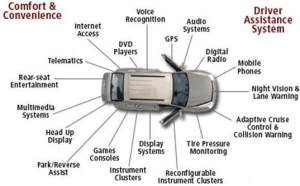
Embedded System in Automobiles
1. Embedded Airbag System
The below figure shows an embedded airbag system – an important safety device that provides extra protection against head-on crash – for the front seat occupants. This System works on the commands from the microcontroller. The controller of this system gets the power from the battery. If the sensors detect accident, this microcontroller operates the airbag system by operating alternator.
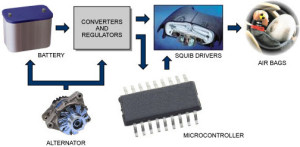
Embedded Airbag System
2. Embedded Navigation System
Another advancement of the embedded system in automobiles is the navigational system using GPS system. This navigational system consists of an embedded circuitry built with a GPS receiver, a gyroscope, a DVD-ROM, main controller and a display system as shown in the figure. The GPS receiver receives the current longitude and latitude values that are compared with the stored map. The Gyroscope and other sensors provide the road direction and speed. From all the information gathered at the main controller, the display system displays a navigation or route map of the destination in the display screen.
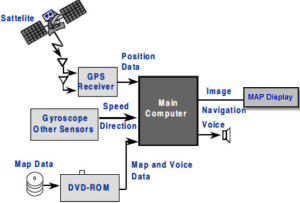
Embedded Navigational System
3. Adaptive Cruise Control
The innovation of the embedded system used in automobiles is Adaptive cruise Control technology. By using this technology we can also make driverless vehicle control in a reality and many automobile manufacturers are also already engaged in work on these concepts. This adaptive cruise control allows cars to keep safe distances from other vehicles on the busy highway roads. The driver of the car can set the speed of his vehicle and the distance between his car and other vehicles. When the traffic slows down, ACC changes vehicle speed using moderate braking.
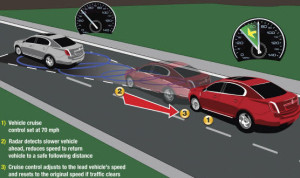
Adaptive Cruise Control
Each car has a laser transceiver or a microwave radar unit which is fixed in front of the car to find out the speed and distance of the any other vehicle in the pathway. This is works on the principle of Doppler Effect; it is nothing but change in frequency of the waves.
4. Embedded Rain-Sensing System
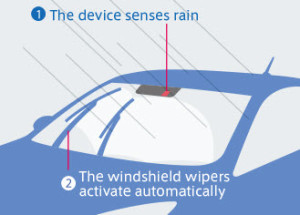
Embedded rain-sensing system
Embedded rain-sensing system in automobiles is another automation system implemented with use of electronic system. In this, an optical sensor is placed on small area of the front windshield glass (opposite to rear-view mirror). This optical sensor is placed at an angle to emit the infrared light which then reads amount of light by it when the light is reflected back. This light is reflected in cases where the windshield is wet or dirty. Thus the optical sensor determines necessary speed and frequency of windshield wiper depends on reflected light into the sensor.
5. Embedded Based Automatic Parking System
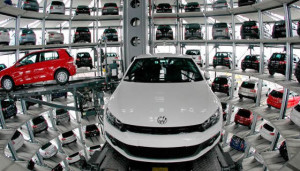
Embedded Based Automatic Parking System
This automatic parking system is an independent car manipulation system that moves a car from traffic lane into a parking spot to perform the parallel parking, perpendicular parking and angle parking. This system mainly uses different methods to detect objects around the car. Sensors installed on the front of the vehicle and rear bumpers acts as both a transmitter and a receiver. These sensors send a signal that will be replicated back when it meets an obstacle near the vehicle, and then the carputer will receives the time signal and bumper will use the radar to decide the position of the obstacle. The car will sense the parking space and distance from the side of the road then drive the car into the parking place.
Please refer to this link to know more about FPGA.
Please refer to this link to know more about PID Controller MCQs, Embedded Systems MCQs
Thus, the modern days embedded systems have marked a revolutionary change in every aspect of the automobile designing and manufacturing processes because of their adaptability and flexibility. Now the question is: Have you got the basic concept of embedded systems in automobiles? If you have got some basic understanding of this concept with a little bit of doubt on this topic, you can give your feedback and suggestions in the comment section below, and let us know how would you like to get some help or assistance from us.
Photo Credits:
- Automobiles by sssup
- Examples of embedded systems by washington
- Embedded Airbag System by maximintegrated
- Embedded Based Automatic Parking System by mitraotomasisampoerna